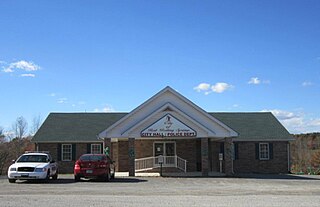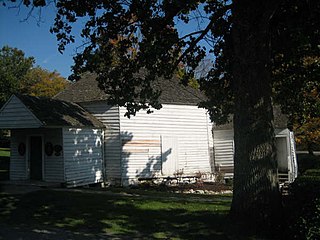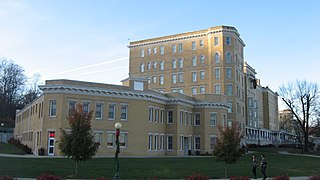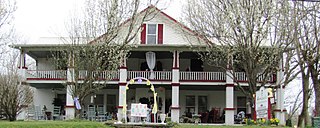
Grainger County is a county located in the U.S. state of Tennessee. As of the 2020 census, the population was 23,527. Its county seat is Rutledge. Grainger County is a part of both the Knoxville Metropolitan Statistical Area and Morristown Metropolitan Statistical Area.

Blaine, formerly known as Blaine's Crossroads, is a city in Grainger County, Tennessee, United States, and a suburb of neighboring Knoxville. It is part of both the Knoxville Metropolitan Statistical Area and the Morristown Metropolitan Statistical Area. The population was 2,084 at the 2020 census.

Rutledge is a city in and the county seat of Grainger County, Tennessee. The city is part of both the Knoxville metropolitan area and the Morristown metropolitan area. As of the 2020 census, the city had a total population of 1,321.

Red Boiling Springs is a city in Macon County, Tennessee, United States. The population was 1,205 at the 2020 census.

The Omni Bedford Springs Resort is a resort hotel which is located outside of Bedford, Pennsylvania. Established in 1806, it is one of last and best-preserved of 19th-century resort hotels based around mineral springs.

Bean Station is a town in Grainger and Hawkins counties in the state of Tennessee, United States. As of the 2020 census, the population was 2,967. It is part of the Kingsport Metropolitan Statistical Area, Knoxville Metropolitan Statistical Area, and Morristown metropolitan statistical area. Established in 1776 as a frontier outpost by pioneer William Bean, it is considered one of the earliest permanently settled communities in Tennessee. It grew throughout the rest of the 18th and 19th centuries as an important stopover for early pioneers and settlers in the Appalachia region due to its strategic location at the crossroads of Daniel Boone's Wilderness Road and the Great Indian Warpath.
Minnehaha Springs is an unincorporated community located in Pocahontas County, West Virginia, United States. It was named for the fictional Native American "princess," Minnehaha, and the mineral springs on the Lockridge farm. It is the only community with this name in the United States. On the site of what is now Camp Twin Creeks warm mineral springs can still be found.

U.S. Route 11W (US 11W) is the western branch of US 11 from the twin cities of Bristol, Tennessee/Bristol, Virginia, where US 11 splits into US 11E and US 11W, to Knoxville, Tennessee, where the two highways rejoin. The highway serves the Appalachia region's Ridge-and-Valley section of East Tennessee, bounded by the Clinch Mountain ridge to the north and the Holston River to the south. US 11W from Bristol to Bean Station and Blaine to Knoxville are designated as part of the National Highway System.

Gilroy Yamato Hot Springs, a California Historical Landmark and on the list of National Register of Historic Places, is a property near Gilroy, California famed for its mineral hot springs and historic development by early settlers and Japanese immigrants. The earliest extant Italianate–Victorian style structures date from the 1870s, and the earliest bathhouse dates from 1890. Other early structures are a Buddhist shrine from 1939 and a Japanese garden teahouse from that same year. The property is also listed on the National Register of Historic Places. The hot spring's temperature ranges from 99° to 111 °F. These springs are the site of occurrence of certain extremophile micro-organisms, that are capable of surviving in extremely hot environments.

U.S. Route 25E (US 25E) is the eastern branch of US 25 from Newport, Tennessee, where US 25 splits into US 25E and US 25W, to North Corbin, Kentucky, where the two highways rejoin. The highway, however, continues as US 25E for roughly two miles (3.2 km) until it joins Interstate 75 (I-75) in the Laurel County community of North Corbin at exit 29. The highway serves the Appalachia regions of Kentucky's Cumberland Plateau and the Ridge-and-Valley section of East Tennessee, including the urbanized areas of Corbin and Middlesboro in Kentucky and Morristown in Tennessee.

Clinch Mountain is a mountain ridge in the U.S. states of Tennessee and Virginia, lying in the ridge-and-valley section of the Appalachian Mountains. From its southern terminus at Kitts Point, which lies at the intersection of Knox, Union and Grainger counties near Blaine, Tennessee, it runs in a generally east-northeasterly direction to Garden Mountain near Burke's Garden, Virginia. It separates the Clinch River basin to the north and the Holston River basin to the south.

Cherokee Lake, also known as Cherokee Reservoir, is an artificial reservoir in the U.S. state of Tennessee formed by the impoundment of the Holston River behind Cherokee Dam.

Highland Springs is a set of springs which was turned into a resort in the 19th century in Lake County, California. The resort grew to be able to accommodate 200 people, attracted by the curative powers of the mineral waters and the lovely mountain scenery. In the 1920s its popularity waned, the hotel was partly burned, and it passed through various hands before the county claimed eminent domain, bought the property, and flooded it with the Highland Springs Reservoir. The reservoir is surrounded by the Highland Springs Recreation Area, managed by the county.

The Warm Springs Pools are two spa structures near Warm Springs, Virginia. The name was changed in the 20th century from "Warm Spring Pools" to "Jefferson Pools" before being returned to its original name in 2021. The spa is part of The Homestead, a resort hotel in nearby Hot Springs.

The French Lick Springs Hotel, a part of the French Lick Resort complex, is a major resort hotel in Orange County, Indiana. The historic hotel in the national historic district at French Lick was initially known as a mineral spring health spa and for its trademarked Pluto Water. During the period 1901 to 1946, when Thomas Taggart, a former mayor of Indianapolis, and his son, Thomas D. Taggart, were its owners and operators, the popular hotel attracted many fashionable, wealthy, and notable guests. The resort was a major employer of African-American labor, which mostly came from Kentucky.

Joppa is an unincorporated community in rural central-western Grainger County, Tennessee, United States. It rests below Joppa Mountain, a subrange located near the southern terminus of the 150 mile (240 km) long Clinch Mountain ridge complex, offering views of five U.S. States and the Great Smoky Mountains. Joppa is part of the Morristown, Tennessee Metropolitan Statistical Area, and also a component of the Knoxville-Morristown-Sevierville Combined Statistical Area.

Mooresburg is a census-designated place (CDP) and an unincorporated town in Hawkins County, Tennessee. Its population was 941 as of the 2010 census. It is located along U.S. Route 11W between Rogersville and Bean Station.

Armour's Hotel, formerly the Counts Hotel, is a historic hotel on East Main Street in Red Boiling Springs, Tennessee, United States. Built in 1924, this is one of three hotels remaining from the early-20th century resort boom at Red Boiling Springs. In 1986, it was added to the National Register of Historic Places along with the Donoho Hotel and the Thomas House. Armour's Hotel is the only Red Boiling Springs hotel still offering the mineral springs services that made this area an attraction in the 1890s and early 20th century.

Tate Springs is an unincorporated community in Grainger County, Tennessee and neighborhood of Bean Station. It is part of the Morristown Metropolitan Statistical Area which consists of Grainger, Hamblen, and Jefferson counties.

The 1972 Bean Station bus-truck collision was a head-on collision involving a double-decker Greyhound bus and a tractor-trailer on U.S. Route 11W in Grainger County, Tennessee, that occurred near the town of Bean Station on the morning of May 13, 1972.























